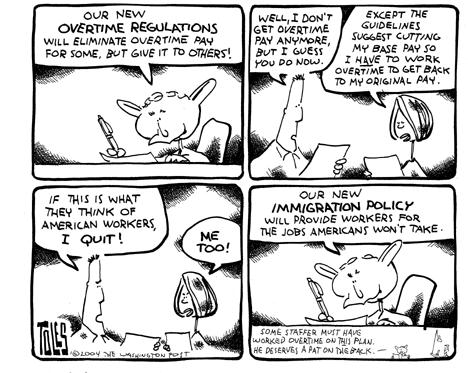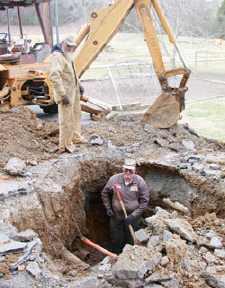The Weekly Toll
Construction worker killed at Xcel station
A construction worker was killed at an Adams County Xcel station Friday when the boom of a machine lift hit the victim.
The victim, whose identity and age were not available Friday, was dead at the scene, an Adams County sheriff's sergeant said.
An Xcel spokesman said the employee worked for Forerunner Construction, which had been building a wastewater filter for Xcel's Cherokee Generating Station.
The victim was operating a four-wheel drive forklift about 10:45 a.m. and trying to carry a long section of a pipe at the station, 6198 Franklin St., when the machine began to tip over, a fire official said. The victim jumped out of the machine, but the boom of the lift fell on top of him.
Worker killed as truck bed collapses
A Port St. Lucie, FL, man was killed Thursday morning when the hydraulic bed of a dump truck collapsed on him at the St. Lucie County landfill.
Bruce Caldarone, 52, head mechanic of Choice Sanitation, was injured at 11:06 a.m. after he went to the landfill at 6130 Glades Cut-Off Road to fix the truck, according to a St. Lucie County sheriff's report
Cal-OSHA probes death of worker
The Sacramento district office of Cal-OSHA is investigating the
death of electrical worker Randall Imai, 54, who died Monday when he fell more than 25 feet from a utility pole in Woodland. Imai had worked for Pacific Gas and Electric for 29 years.
Falls account for a high number of on-the-job fatalities in the construction industry, said Cal-OSHA spokesman Dean Fryer. In 2002, the most recent year for which figures were available, 58 people in California died from falls, down from 93 in 2001, he said.
"Working with electrical and natural gas is a very, very dangerous occupation," said Eric Wolfe, communications director for International Brotherhood of Electrical Workers Local 1245, to which Imai belonged for 29 years. "We stress safety ... yet people still die because of the inherent dangers of the job. It just takes one slip or one thing that happens out of your control and you're gone."
Editor Note: Yes, it's very dangerous, even inherently dangerous, but was this something out of the worker -- or employer's control? Did the "inherent dangers" kill him, or unsafe conditions? I don't know anything about the details of this accident, there are few falls that couldn't have been prevented.
Bar owner shot to death during robbery
NEW ORLEANS (AP) —
The owner of a neighborhood bar was shot to death in an armed robbery, and police were on the lookout for two suspects.
Emmett Sindik was the owner and a bartender at the Clematis Bar, a popular hangout in the Gentilly neighborhood.
Man, 61, killed in silo accident
A 61-year-old Archer Daniels Midland Co. employee, Richard J. Waniorek, was killed in an industrial accident inside a silo at the company's West Milwaukee plant Tuesday, authorities said.
The man, whom police and fire officials declined to identify, apparently became pinned about 1:45 p.m. in some type of a filtering silo at the facility
Man Killed in Trench Collapse
MOORESVILLE, N.C. -- Hospital officials released the identity of a construction worker killed Friday when
he was buried in a ditch that caved in while he was digging new water and sewer lines for a residential development.
Charles Tudor, of Lake Norman Regional Medical Center, said 43-year-old
Lee Fults, of Lawndale, was installing the new sewer line about 10 to 12 feet under the ground behind a town house development along N.C. Highway 115. More
here.
Man from Waterloo is killed in accident
A worker was killed Friday morning in an accident at a metal manufacturing plant in St. Louis where he had worked for several years, officials said.
John Huntley, 46, of Waterloo, was killed just before 9 a.m. at Continental Fabricators Inc., 5601 West Park Avenue. He had been working inside a sulfur condenser - a 10-foot-high and 8-foot-wide metal cylinder being built by Continental.
A 1-ton, circular steel plate on which he was standing near the bottom of the condenser tilted upward, causing Huntley to slide into the gap, said Kim Bacon, a spokeswoman for the St. Louis Fire Department. The plate then righted itself, crushing Huntley against the inner wall of the condenser and killing him, Bacon said.
Worker servicing ATM in Jackson shot to death
JACKSON, MS -
A worker was shot to death on New Year's Day as he got ready to service an automated teller machine in south Jackson.
Jackson police spokesman Robert Graham said officers were searching for suspects in the killing of
Frank Hedgepeth, 50, of Clinton.
Worker Killed In Eight-Story Fall
PHILADELPHIA (KYW)
An electrical worker was killed, after police say he apparently fell out of a eight-story window at the Victory Building at 10th and Chestnut Streets in Center City Philadelphia.
***
The accident is under investigation by local officials and OSHA. Authorities were checking if the man might have been pulled out of the window by the weight of an electrical cable.
Sanitation worker is killed in truck
Christopher Todd Goodwin, 28, gets caught in compactor
A 28-year-old Mobile man was crushed to death Wednesday morning in Theodore by the compactor of a garbage truck when he climbed inside to free a jam, authorities said.
Christopher Todd Goodwin, who worked for the family-operated Goodwin Sanitation, was killed about 7 a.m. while picking up garbage in the 6300 block of Rester Road near Interstate 10, said officer Eric Gallichant, a Mobile police spokesman.
"He was attempting to free some debris that had caused the trash compactor to jam when he became pinned inside," Gallichant said.
Mill worker killed by conveyor belt
JACKMAN, ME --
A Cornville man was killed early Wednesday morning when he got tangled up in a conveyor belt he was working on at Moose River Lumber, police said.
Robert R. Robichaud, 34, died at the scene of the accident outside the saw mill on the Tapley Road, according to Deputy Paul A. York of the Somerset County Sheriff's Department. Robichaud was a single father of a son and two daughters.
Landscaping worker killed when golf cart overturns in Mission Viejo
MISSION VIEJO, Calif. -
A golf course landscaping worker was killed after he lost control of a golf cart he was driving and it rolled over on top of him, authorities said.
The 37-year-old Garden Grove man,
Juan Gomez, was crushed by the cart at the Arroyo Trabuco golf course at about 10:45 a.m. Wednesday, said police Lt. Phil Johnson.
School Maintenance Worker Killed In Freak Accident
LEBANON, Pa. --
A maintenance worker at Lebanon High School was killed Tuesday in an apparent freak accident.
Police suspect
Michael Fortna, 37, was electrocuted while working in the school's gym, removing volleyballs that were stuck in light fixtures -- a routine chore that officials said he had done many times before.
Crane collapse kills Vinton man in Iberia Parish
LOREAUVILLE, LA (AP) -- Federal investigators tried to determine Tuesday whether a crane malfunctioned when its
boom fell on a construction worker and killed him.
The victim, identified as
Charles Butler Mathews, 56, of Vinton, was working Monday on a bridge over the Loreauville canal on Highway 86. The state is replacing the two-lane span, known locally as the Teche Lake Bridge.
Man's Arm Severed Saving Co-Worker
Authorities and co-workers are calling a western Pennsylvania construction foreman a hero the day after he pushed another worker out of the way of a falling forklift --
and had his arm severed at the shoulder as a result.
John Andrew, 53, of Baldwin Borough was hurt Tuesday morning when a passing truck hit the forklift causing it to topple at a job site for MBM Contracting -- a firm doing work in its hometown of Homestead, just east of Pittsburgh
Fast Food Employee Killed in Robbery
A San Antonio man, Christopher Roel, is dead after three suspects robbed a fast food restaurant late Tuesday night.
Police say the the suspects hit the Sonic Drive-In on the 2300 block of Blanco Road near Hildebrand after 11 p.m. Tuesday. More
here.

